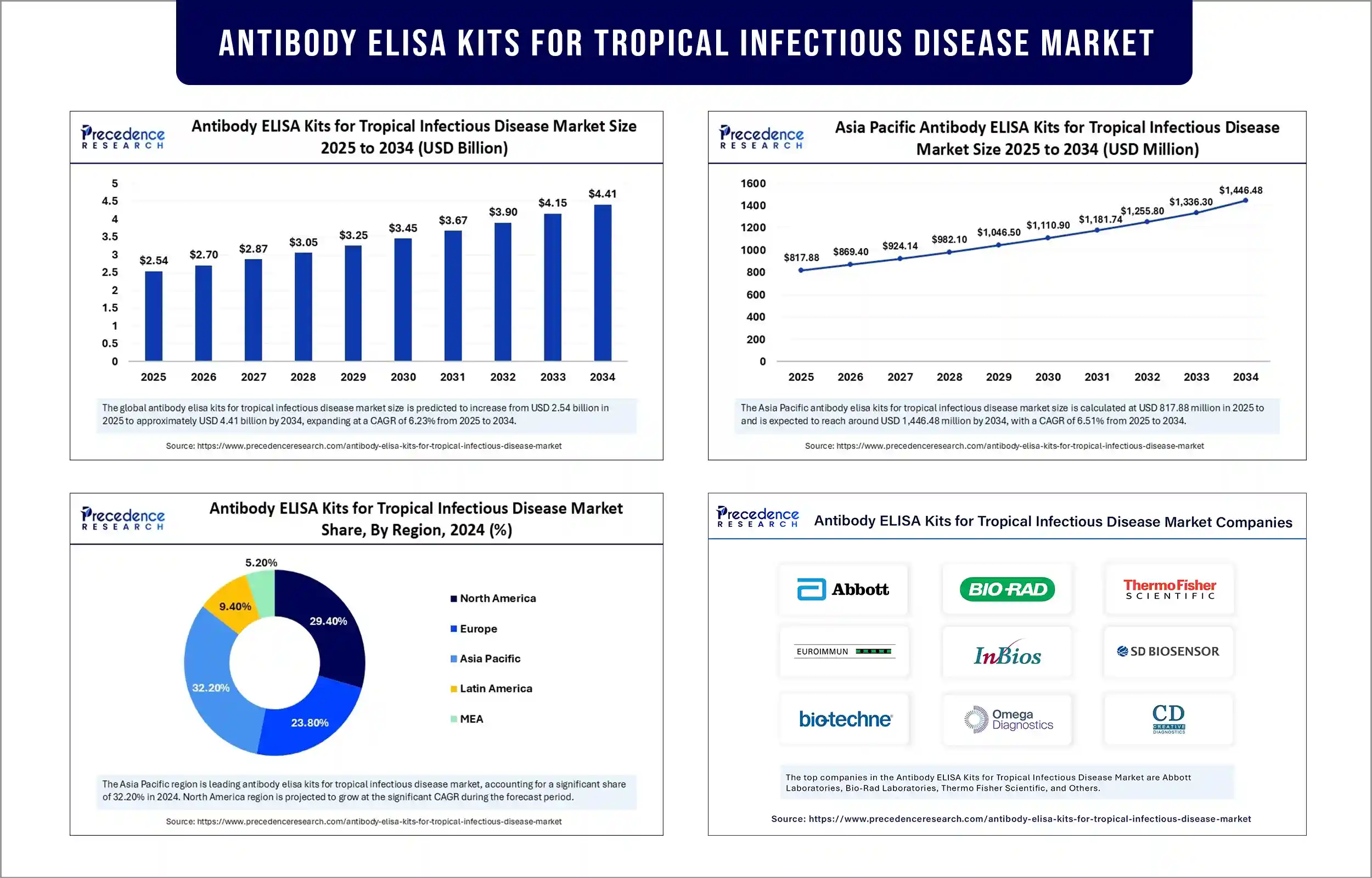Antibody ELISA Kits for Tropical Infectious Disease Market Revenue to Attain USD 4.15 Bn by 2033
Antibody ELISA Kits for Tropical Infectious Disease Market Revenue and Trends 2025 to 2033
The global antibody ELISA kits for tropical infectious disease market revenue surpass USD 2.54 billion in 2025 and is predicted to attain around USD 4.15 billion by 2033, growing at a CAGR of 6.32%. The growth of the market is attributed to the increasing prevalence of infectious diseases, the rising demand for rapid diagnostics, and the expanding global healthcare infrastructure.

Market Overview
The antibody ELISA kits for tropical infectious disease market experiencing significant growth due to the rising incidence and outbreak of diseases such as malaria, dengue, chikungunya, and Zika virus. This significantly heightened the need for timely, accurate, and cost-effective diagnostic tools. Governments’ health initiatives, funding for R&D, and partnerships with NGOs are boosting demand for antibody ELISA kits, particularly in rural, resource-limited settings. The introduction of new ELISA technologies, offering enhanced sensitivity, quicker turnaround times, and suitability for point-of-care applications, is further propelling market growth. There is a heightened awareness of the benefits of early detection, expanding healthcare and testing infrastructure, and a trend toward preventive healthcare and large-scale surveillance programs in lower-income countries are opening up new growth opportunities.
Segment Insights
- By disease type, the dengue segment held the highest share of the market in 2024 due to its high prevalence and high transmission rates, creating the need for quicker detection.
- By antibody type, the IgM segment led the market in 2024, as IgM-based ELISA kits are crucial for the timely diagnosis of diseases like dengue, chikungunya, and Zika. They are essential for the detection of early-stage infections. The growing need for rapid diagnosis of infectious diseases further bolstered segmental growth.
- By sample type, the serum segment held the largest market share in 2024 due to its high accuracy, reliability, and efficiency in testing and diagnostics.
- By technology, the indirect ELISA segment contributed the highest market share in 2024, as it offers better sensitivity, specificity, and the potential for cost-efficient diagnostics for infectious diseases.
- By end-user, the diagnostic laboratories segment dominated the market with the largest share in 2024, owing to its well-established infrastructure, skilled expertise, and access to large volumes of samples associated with diagnostic tests.
- By distribution channel, the distributors/wholesalers segment led the market due to their extensive networks that ensure wide and timely product availability across diverse regions. They help manufacturers reach remote and underserved areas, enhancing market penetration.
Regional Insights
Asia Pacific held the largest share of the antibody ELISA kits for tropical infectious disease market in 2024, driven by the widespread prevalence of tropical infectious diseases, such as dengue, chikungunya, and malaria. Market growth is supported by expanding healthcare infrastructure, government initiatives for disease surveillance, and increased investment in diagnostic technologies. Countries like India, Indonesia, and the Philippines have seen rapid adoption of next-generation ELISA kits to manage large-scale outbreaks. Furthermore, favorable economic conditions and greater awareness of diseases and the importance of early detection further bolstered market growth.
The market in the Middle East & Africa is expected to grow at a rapid pace due to the rising burden of malaria, yellow fever, and various other vector-borne infections. International organizations supporting projects such as humanitarian aid, NGOs acting in a public health capacity, and the increased penetration of tests at affordable prices are facilitating adoption. South Africa, Nigeria, and Kenya are the most prominent contributors. Rising investments to boost laboratory testing capabilities and high demand for accurate diagnostic testing further support market growth.
Antibody ELISA Kits for Tropical Infectious Disease Market Coverage
| Report Attribute | Key Statistics |
| Market Revenue in 2025 | USD 2.54 Billion |
| Market Revenue by 2033 | USD 4.15 Billion |
| CAGR from 2025 to 2033 | 6.32% |
| Quantitative Units | Revenue in USD million/billion, Volume in units |
| Largest Market | Asia Pacific |
| Base Year | 2024 |
| Regions Covered | North America, Europe, Asia-Pacific, Latin America, and Middle East & Africa |
Recent Development
- On July 21, 2025, the Indian Council of Medical Research (ICMR) unveiled an advanced IgM-based ELISA kit for Chikungunya detection, boasting an impressive 95% diagnostic accuracy. It has also been independently validated by the U.S. CDC. ICMR is currently inviting expressions of interest (EoIs) for technology transfer and commercialization. (Source: https://www.newkerala.com)
Antibody ELISA Kits For Tropical Infectious Disease Market Key Players
- Abbott Laboratories
- Bio-Rad Laboratories
- Thermo Fisher Scientific
- Euroimmun (a PerkinElmer Company)
- InBios International
- SD Biosensor
- Bio-Techne Corporation
- Omega Diagnostics
- Creative Diagnostics
- DRG International
- DiaPro Diagnostic Bioprobes
- NovaTec Immundiagnostica GmbH
- BioServUK
- Artron Laboratories
- Meridian Bioscience
- GenWay Biotech
- MyBioSource Inc.
- Calbiotech Inc.
- Diagnostic Automation/Cortez Diagnostics Inc.
- MP Biomedicals
Get this report to explore global market size, share, CAGR, and trends, featuring detailed segmental analysis and an insightful competitive landscape overview @ https://www.precedenceresearch.com/sample/6571
You can place an order or ask any questions, please feel free to contact at sales@precedenceresearch.com |+1 804 441 9344